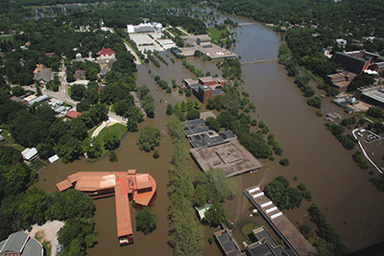
Why does a large institution build in a flood-prone area and how does it respond when flooding causes great damage? That is the question answered in an article by three Urban Planning faculty recently published in the Journal of Planning History. "Planning for Floods at the University of Iowa: A Challenge for Resilience and Sustainability," written by Charles Connerly, Lucie Laurian and James Throgmorton (emeritus), can be found in the May 2016 issue.
This is a case study of a major flood event—the 2008 Iowa–Cedar River flood—and the University of Iowa, whose recovery is expected to cost about $750 million. The case explores the factors that led a major institution to invest so much of its infrastructure into a flood-prone river shed and then describes and evaluates the decision-making process the University has undertaken with the goal of becoming a more sustainable and resilient campus. The full article can be found online.